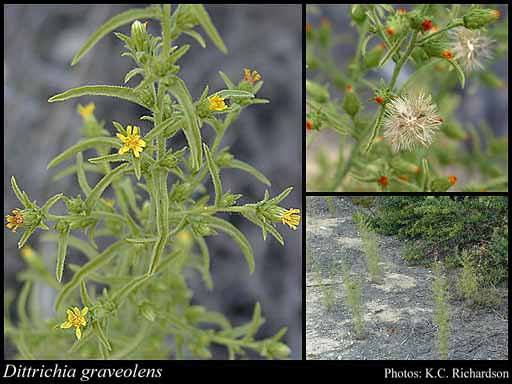- Reference
- Exsicc.Genav.Conserv.Bot.Distrib.Fasc. 4:71 (1973)
- Conservation Code
- Not threatened
- Naturalised Status
- Alien to Western Australia
- Name Status
- Current
Erect, bushy, viscid, aromatic annual, herb, 0.1-0.5(-1) m high. Fl. yellow/yellow-white, Jan to Nov. Variety of soils. Weed of waste grounds, along rivers, roadsides.

Distribution
- IBRA Regions
- Avon Wheatbelt, Coolgardie, Esperance Plains, Geraldton Sandplains, Hampton, Jarrah Forest, Mallee, Murchison, Swan Coastal Plain, Warren.
- IBRA Subregions
- Dandaragan Plateau, Eastern Goldfield, Eastern Murchison, Fitzgerald, Geraldton Hills, Hampton, Katanning, Lesueur Sandplain, Mardabilla, Merredin, Northern Jarrah Forest, Perth, Recherche, Southern Jarrah Forest, Warren, Western Mallee.
- IMCRA Regions
- Central West Coast, Leeuwin-Naturaliste, WA South Coast.
- Local Government Areas (LGAs)
- Albany, Armadale, Bayswater, Bunbury, Busselton, Carnamah, Chittering, Cockburn, Collie, Dalwallinu, Denmark, Dumbleyung, Dundas, Esperance, Gingin, Gosnells, Greater Geraldton, Harvey, Kalgoorlie-Boulder, Kent, Kulin, Kwinana, Lake Grace, Mandurah, Manjimup, Menzies, Mingenew, Mundaring, Murray, Narrogin, Nedlands, Northampton, Perth, Pingelly, Plantagenet, Ravensthorpe, Rockingham, Serpentine-Jarrahdale, Stirling, Swan, Victoria Plains, Vincent, Wagin, Wandering, Wanneroo, Waroona, Williams, Yilgarn.
Management Notes (for the Swan NRM Region)
Alternative Names. Camphor Inula, Cape Khakiweed, Stinking Fleabane, Stinkweed.
General Biology. Growth form. Herb. Life form. Annual. Reproduction. Seed. Dispersal. Wind, water, agricultural activity, machinery, vehicles, animals (especially on wool and fur). Toxicity. Poisonous to livestock, can cause dermatitis and skin irritation in people. Seedbank persistence. Up to 3 years.
Notes. Adapted to temperate Mediterranean climates with winter-dominant rainfall. Tends to colonise open areas. Strongly aromatic. Produces prolific seed that secretes a sticky exudate that causes seed to cling to clothing, animal fur and machinery. The similar species Dittrichia viscosa has abundant glandular hairs that show allelpathic and microbial properties. Declared plant in Victoria.
Additional information. Origin. Northern Africa, temperate and tropical Asia, Europe. Similar exotic species. Dittrichia viscosa.
Suggested method of management and control. Hand remove isolated plants before flowering. Slash close to ground otherwise plants can resprout. Any treatment should be applied twice, early and then late summer. Apply glyphosate at 1% when plants are small, or up to flowering. Clean equipment, clothing and shoes, etc. to prevent spread of seed. Read the manufacturers' labels and material safety data sheets before using herbicides. For further information consult the Australian Pesticides and Veterinary Medicines Authority to determine the status of permits for your situation or state.
Management Calendar
| Calendar Type | Jan | Feb | Mar | Apr | May | Jun | Jul | Aug | Sep | Oct | Nov | Dec | Comments |
|---|---|---|---|---|---|---|---|---|---|---|---|---|---|
| Germination | Y | Y | Y | ||||||||||
| Active Growth | Y | Y | Y | ||||||||||
| Flowering | Y | Y | Y | Y | |||||||||
| Fruiting | Y | Y | Y | ||||||||||
| Manual Removal | Y | Y | Y | ||||||||||
| Herbicide Treatment | O | Y | Y |
Legend: Y = Yes, regularly, O = Occasionally, U = Uncertain, referred by others but not confirmed.
References
- Anon. (2007) Weed Alert: Dittrichia graveolens. Santa Clara Weed Management Area URL: http://www.bpaonline.org/habitat/dittrichia_weed_alert_flyer.pdf - Accessed July 2010.
- Brown, K. & Brooks, K. (2002) Bushland Weeds: A Practical Guide to their Management. Environmental Weeds Action Network, Greenwood.
- Csurhes, S. & Zhou, Y. (2008) Pest plant risk assessment, Stinkwort, Dittrichia graveolens. Department of Primary Indutries and Fisheries, Queensland, Brisbane.
- Hussey, B.M.J., Keighery, G.J., Dodd, J., Lloyd, S.G. & Cousens, R.D. (2007) Western Weeds. A guide to the weeds of Western Australia. 2nd Edition. The Plant Protection Society of Western Australia, Victoria Park.
- Parsons, W.T. & Cuthbertson, E.G. (2001) Noxious weeds of Australia. 2nd Edition. CSIRO Publishing, Collingwood.
- Philbry, A.W. & Morton, A.G. (2000) Pyogranulomatous enteritis in sheep due to penetrating seed heads of Dittrichia graveolens. Australian Veterinary Journal,.
- Starrianakou, S., Liakopoulos, G. & Karabourniotis, G. (2006) Boron deficiency effects on growth, photsynthesis and relative concentrations of phenolics of Dittrichia viscosa (Asteracea). Environmental and Experimental Botany, 56: 293-300.
- Thong, H., Yokota, M., Kardassakis, D. & Maibach, H.I. (2008) Allergic contact dermatitis from Dittrichia graveolens (L.) Greuter (stinkwort). Contact dermatitis, 58: 51-53.
- USDA, ARS, National Genetic Resources Program (2009) Germplasm Resources Information Network - (GRIN). National Germplasm Resources Laboratory, Beltsville, Maryland. URL: https://npgsweb.ars-grin.gov/gringlobal/taxon/taxonomysimple.aspx - Accessed October 2009.